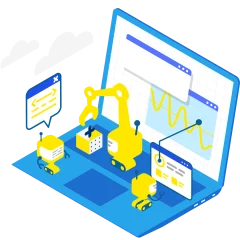There it is, the new software idea. “Let’s not waste any time”, you think to yourself. But the road to introducing new software products can be a rocky one if it is not approached correctly. There are often many pitfalls awaiting you, such as expectations that are too high or inefficient and slow development steps.
This can be remedied by implementing a minimal viable product (MVP). This article deals with the basic concepts and advantages of MVPs, as well as practical strategies and proven methods for efficiently achieving product market maturity.
What is a minimal viable product?
A Minimal Viable Product, or MVP for short, is software that only contains the most necessary functions to meet the needs of the first users. This leaves room for iterative improvements.
Internally, however, I like to translate it (albeit not 100% correctly) as minimal lovable product. Why? It’s not perfect, but just lovable enough to be accepted and used by early adopters. Regarding “perfect”, the following quote fits very well:
If you’re not embarrassed by the first version of your product, you’ve launched too late
Reid Hoffman, Founder of LinkedIn
But it doesn’t have to be perfect, nor should it be. MVP development represents a strategic development step that enables product developers like us to bring software products to market faster in order to gather customer feedback at an early stage and optimize time-to-market.
The benefits of an MVP
Far too often, customers assume that the new product idea cannot be extensively validated if the prototype does not meet their far too high expectations. Unfortunately, it only becomes clear far too late that this is not possible without investing immense resources in the project. In the meantime, while you are lulled into perfectionism, the competitor may have already developed a market-ready product that provides them with valuable user data. So let’s take a closer look at the advantages of MVPs for companies.
Accelerated time-to-market
One of the main aspects is the drastic reduction in time-to-market. By focusing on the essential core functions, no unnecessary time is spent on features that are of no use to product validation. So there is absolutely no reason to spend time on pretty animations if important process functions are still outstanding. Sure, visual aspects contribute to user-friendliness, but they can always be added later. If some people can be hard on themselves here, an MVP creates clear competitiveness and potential for early revenue generation by getting to market quickly.
Minimizing development risks
If the implementation of a product idea is approached with overly high expectations and full conviction, unnecessary functions are often designed that drive up the project volume.Or functions that contribute to the core of product validation but are already planned far too elaborately.This harbors enormous development risks, as the effort increases and goes far beyond what is actually sufficient for the beginning.
A step-by-step and iterative implementation of functions can be helpful here.In this way, potential weaknesses and challenges can be identified before they develop into serious obstacles. This leads to an increase in the overall efficiency of the development process as unnecessary waste of resources is avoided in advance.
Early customer feedback
The “process function” mentioned can be an input screen or a funnel, for example.The advantage of the MVP approach is that you can evaluate user input and guidance at an early stage and thus learn how your users feel about your product at an early stage.With iterative development cycles and A/B tests, product teams can then ensure that the funnel experience for users is constantly expanded and improved. Based on real user experiences, the requirements and expectations of the market can be precisely met.This close connection to the customer is not only crucial for the development of customer-oriented products, but also minimizes the risk of costly product adjustments after market launch.
Planning the MVP process
It has now become clear which functions should be primarily focused on and which can be neglected.But how is an MVP planned?
The focus is on solving the problem that the future product is intended to solve.What added value do you want to offer your target group?Answering these questions helps to develop a clear definition and product vision that is dedicated exclusively to solving the problem. Everything else can and must wait. Ideally, key functions for the MVP will now emerge that serve as a guide and basis for an efficient development process.
It is now clear that the main focus should be on the functions that address the user’s core problem and at the same time guarantee the basic functionality of the product. By defining the minimum requirements, it is now ensured that the MVP takes shape with its development and planning steps.
Fast development techniques and tools
When it comes to implementation, i.e. design and programming, an agile development methodology is an effective approach. The iterative nature of agile methods enables flexible adaptation to changing requirements and promotes the continuous integration of customer feedback. Coupled with the use of prototyping techniques, realistic models of the product can be created in the shortest possible time.In addition, the understanding of all stakeholders involved in the project is promoted as to how the product will ultimately develop and whether it will work (or not).
Methods such as Scrum or Kanban offer the flexibility needed to meet rapidly changing requirements.They also promote team collaboration and the continuous delivery of functional software (keyword: iterative). We therefore do not even use a waterfall model due to the limited possibility of validating assumptions and low flexibility.
If individual steps are also automated, development steps can be significantly accelerated and contribute to the overall agility of the project. By automating tests, deployments and other repeatable tasks, development teams save valuable time and can instead focus on the further development of core functionalities.
Strategies for a fast market launch
Development is just the beginning of the road to a successful market launch. In order to exploit the full potential of the MVP, targeted strategies are required that enable a fast and effective placement on the market.
Beta tests and early access programs
With beta tests and early access programs, you can benefit from proven methods to make the product available to a selected group of users and make it palatable. The valuable feedback collected in this way can be incorporated into further product development before it is officially launched on the market.Not only can weak points be identified in this way, but it also creates a feeling of exclusivity among the first users.
Targeted marketing
In order to find out how best to address the desired target group, the advertising drum can already be beaten during the MVP phase. By focusing on the unique features and clear added value of the MVP, companies can arouse the interest and curiosity of potential users. Storytelling elements should also be used to bring customers closer to the vision and benefits of the product.
Partnerships and collaborations
Collaboration with industry-relevant partners opens doors for established networks.The access gained in this way and the synergies that arise can be used to jointly promote and develop the product.
How to ensure successful implementation
The vision is in place, the core functions have been defined. To ensure a successful and smooth implementation of the MVP, there are a few more points to consider:
- Team composition and dynamics: A well-balanced team of experienced developers, designers and product managers determines the success of the product. Not only technical know-how is important here, but the common vision for the product should also be shared.
- Continuous improvement and adaptation: Even if it is often not immediately clear how certain data points should be interpreted: Customer feedback and data evaluations must be responded to immediately. Iterative adjustments make a significant contribution to the MVP’s ability to adapt to market conditions.
- Constant communication: Open and transparent communication with customers is essential. This is important because user results are available on a daily basis, especially in advanced projects. And it is important to react quickly.
Conclusion
Accelerated market launch, early customer feedback, minimization of development risks: It is precisely these benefits that make the MVP model an attractive tool for companies of all sizes. And the product? Yes, it has only become an innovative software product thanks to the sustainable development path and the continuous small steps towards the goal. This increase in value makes the product truly unique, well thought-out and competitive, as it was built with, rather than just for, its users.
If you would also like to avoid lengthy development cycles and get your product ready for the market as quickly as possible, please contact us. Our experts will be happy to advise you.






